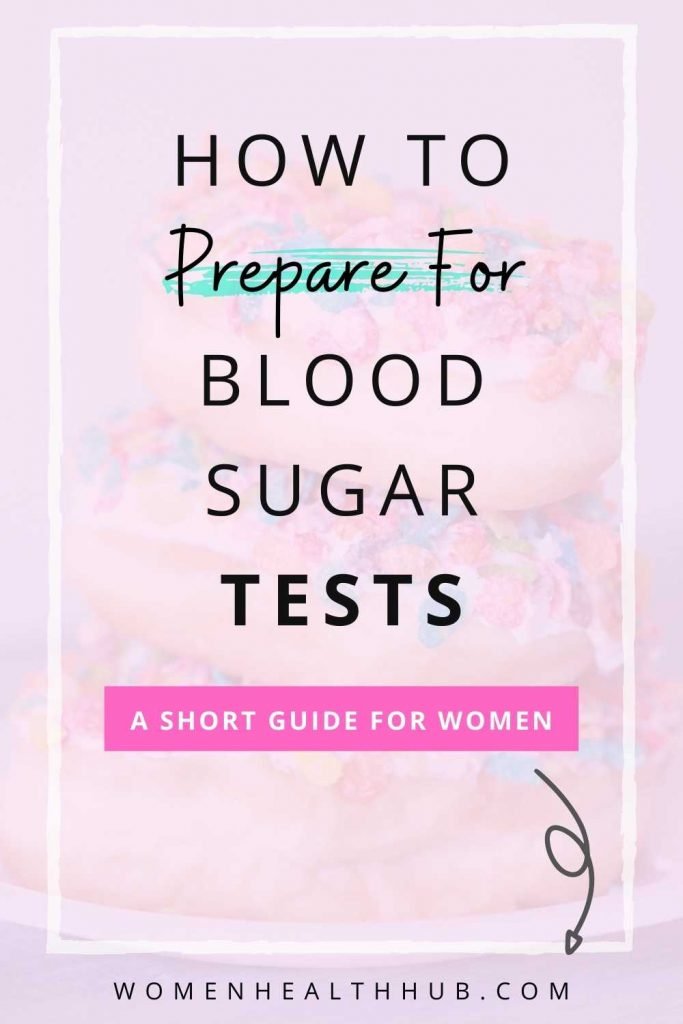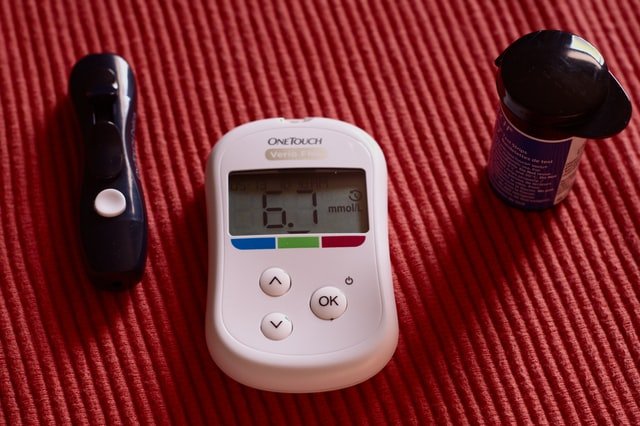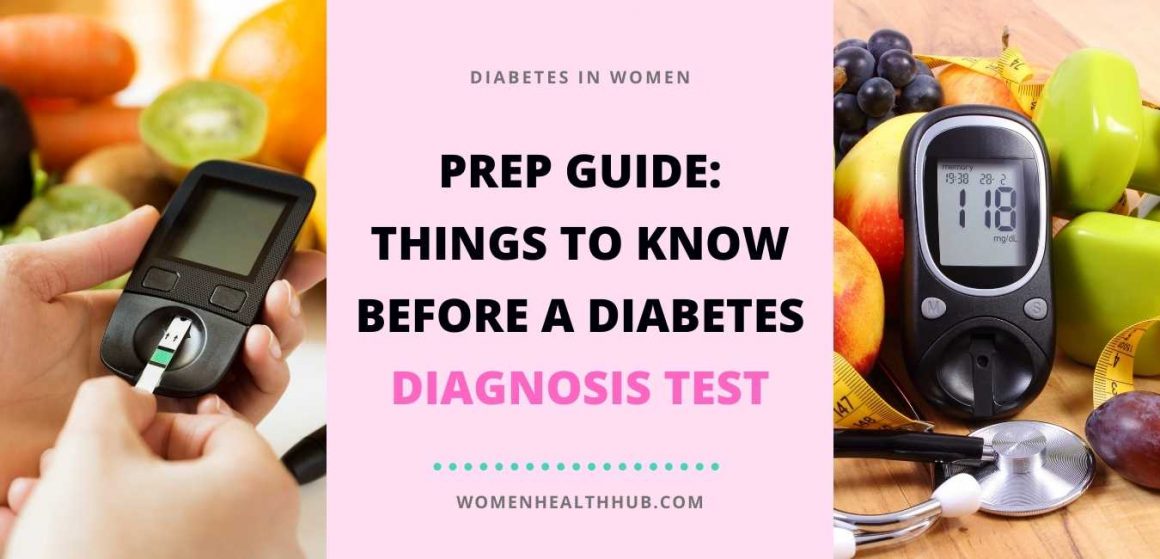Hey there! This post may contain affiliate links. As an Amazon Associate, I earn a teensy commission from qualifying purchases when you buy through these links (at no additional cost to you). For more info, please check the full disclaimer.
Whether you’re pregnant or not, diabetes diagnosis tests are inevitable. At some point, women need to get tested for high blood sugar disease or to figure out the risk of prediabetes.
Diabetes is a serious problem in women. In 2019 alone, about 15 million women were diagnosed with Type 2 diabetes in the US.
And if you get diabetes in pregnancy, it’s even more dangerous!
That’s why it’s extremely important to go for yearly diabetes screening tests.
Now I know, blood tests can be scary. Some diabetes tests require fasting, while others don’t. In some cases, you may even have to drink up fluids.
Don’t be overwhelmed though.
This guide will help you prepare and learn how diabetes is diagnosed in women. This way, you can know what to expect on your next trip.
What is Diabetes?
Before we dive into how diabetes is diagnosed, let’s first understand what it is.
Diabetes is a common chronic or acute disease that raises your blood sugar levels, also known as glucose. Your blood cells are responsible for absorbing glucose and converting it to energy using a pancreatic hormone called insulin.
But sometimes, because of an autoimmune disorder or unhealthy factors, the body fails to produce adequate insulin, or its function is disrupted. As a result, blood sugar levels get too high and cause diabetes.
Diabetes has many health risks for women. So your doctor’s priority would be to test your blood sugar levels ASAP and devise an effective diabetes management plan for you.
Types of Diabetes
You may be tested for the following types of diabetes:
- Type 1 Diabetes
Type 1 diabetes is an autoimmune disease. In this condition, the pancreatic cells are naturally unable to produce insulin as the body kills these cells on its own. As a result, you’ll have to take insulin for the rest of your life to manage the sugar levels.
Usually, Type 1 diabetes diagnostic tests are done during the early years of your childhood because of severe symptoms. Almost 85% of all Type 1 diabetes cases are diagnosed before 20 years of age.
- Type 2 Diabetes
Type 2 diabetes is also caused by either low production of insulin or its improper function. However, it’s not an autoimmune disease. Abnormal blood sugar levels could be caused by continuous stress, overweight, dietary habits, diabetic genes, or inactivity.
The good news is that you might need to take insulin only when necessary. The primary way to manage Type 2 involves regular exercises and a healthy diet. You’ll be asked to go for a Type 2 diabetes diagnostic test if you have serious warning signs of diabetes.
- Prediabetes
If you’re diagnosed with prediabetes, you should pay more attention to your lifestyle. Prediabetes means that your blood glucose levels are higher than normal but not enough to be a diabetic.
You might notice a few symptoms like weight gain or fatigue. Based on these signs, your doctor might ask you to go for a diabetes diagnosis test.
- Gestational Diabetes
Gestational diabetes means high blood sugar levels during pregnancy. It’s one of the most dangerous types of diabetes and should be managed on time. Otherwise, you or your baby might be at risk.
Gestational diabetes affects every 7th birth in the world. Scary, huh?
The blood glucose levels often rise during the third trimester when the placenta begins producing a hormone that stops insulin function. It may cause hyperglycemia or hypoglycemia.
Your OBGYN will probably keep an eye on diabetes symptoms during visits.
Read more: 7 often-missed signs of gestational diabetes
What are the Symptoms of Diabetes?

If your doctor is unavailable and you notice something’s wrong, the best thing you can do is to self-diagnose diabetes at home. You can do this by watching out for any serious symptoms of high blood sugar levels.
Diabetes Type 1 or Type 2 don’t appear overnight. This disease manifests over months.
The signs may be subtle at first. But with time, you might notice prominent changes that point toward an increase in blood glucose.
My primary suggestion would be to visit a doctor as soon as possible. In case that’s not an immediate option, these are some signs of diabetes Type 2 that you should look out for:
- Fatigue
- Swollen feet
- Vaginal infections
- Dark skin patches
- Numbness in arms and legs
- Frequent need to pee
- Sleep disturbance
- Increased infections
Read More: 14 alarming early signs of diabetes
If you notice any of the symptoms mentioned above, you should visit your doctor immediately. The earlier you begin diabetes management, the better it will be for your body.
How Often Should You Go For Diabetes Diagnosis Tests?
According to US yearly health screening guidelines, you have two options:
- Normal sugar before/after 40 years: If you’re aged 40 to 70 years, have always had normal sugar levels, and aren’t at imminent risk of diabetes, then you should go for a diabetes screening test every 3 years.
- Abnormal sugar levels before/after 40 years: Women aged 40 to 70 years who are obese or overweight, have a history of diabetes in the family, or experienced gestational diabetes, should get their blood sugar levels tested every year.
If you’re otherwise a healthy young adult, you should still be careful. Most of the food we eat contains preservatives & sugar. That, along with other lifestyle habits put us at a high risk of getting prediabetes.
Now you might think to yourself, “If I don’t notice any symptoms, why do I need to go for a diabetes test?”
CDC stats show that every 3rd American is a prediabetic. This makes up about 88 million people!
If nothing else, early detection of diabetes risk can help reduce your chances of developing diabetes Type 2 later on. Get your blood sugar checked every 3 years to make sure you’re not a prediabetic.
How is Diabetes Diagnosed in Women?

Many tests help diagnose diabetes Type 1, Type 2, prediabetes, or high blood sugar in pregnancy. Let’s go over the list of the best accurate diabetes tests for women.
For this diagnosis, a doctor will ask you to go for a random blood glucose test for diabetes.
1. A1C Diabetes Test
The A1C diabetes diagnosis test, also known as HbA1C or glycohemoglobin test monitors the glucose that sticks to the hemoglobin protein in your blood cells.
Doctors use it to determine if you have prediabetes or Type 2 diabetes. They may also prescribe a combination of other relevant tests to ensure you don’t have high blood sugar or are at risk.
These diagnostic tests are not used to identify gestational diabetes or Type 1 diabetes, as they can often give false results.
Fasting isn’t required for the A1C diabetes test. It involves taking your blood sample for analysis. Since you don’t need to fast, you can easily go for this diagnostic test for diabetes at any time.
This test measures your average blood sugar levels during the last 3 months. Based on the results of the diabetes diagnosis test, the doctors will create a diabetes management plan for you.
If you’re a diabetic, you may have to go for an A1C test at least twice a year, depending on how well you manage the blood sugar levels. In the case of prediabetes risk, you may be asked to go for confirmation tests once a year.
A1C Test Method:
A health care professional will either take a blood sample from your vein or prick your finger using a lancet. The blood taken from veins is sent for lab analysis.
A1C Test Results:
If your A1C is below 5.7%, congrats! This is normal. If the blood sugar lies between 5.7% to 6.4%, it means you’ve prediabetes. Any results above 6.5% show that you have Type 2 diabetes. Experts recommend keeping the sugar levels below 7%.
Although commonly A1C diabetes diagnosis results are given in percentage, some people prefer to find the Average Glucose or eAG.
Pros & Cons of A1C Diabetes Diagnosis Test:
In the past, the A1C test used to give different readings than others. But now the standards have changed. This diabetes diagnosis test has the most precise results. It also doesn’t show short-term fluctuations in blood sugar levels.
A1C tests are not ideal for those with anemia, thalassemia, recent injurious or surgical blood loss, or sickle cell disease. Defective kidneys or liver can also give false diabetes results.
2. Random Blood Glucose Test
Being one of the most common diabetes diagnosis tests, the random blood glucose method is used to detect Type 1, Type 2, and prediabetes. It is used to identify your blood sugar levels at the present moment.
The random blood glucose test is generally performed after A1C to confirm the results and subsequently give a diagnosis.
You may be asked to go for this test if you show symptoms of high blood sugar disease, such as a frequent need to pee or thirst. Additionally, if you are overweight with a history of diabetes in the family, or have heart problems, this diabetes diagnostic test might be essential for you.
Some Type 2 diabetes patients on insulin also monitor their sugar levels using this method multiple times a day.
So how is diabetes diagnosed using the random blood glucose test?
Again, there’s no need to fast. It’s a pretty straightforward blood test that can be done at any time during the day.
If doctors notice higher than normal glucose levels, they will order more relevant tests for confirmation. Based on the final results, you’ll be given insulin and asked to make some lifestyle changes.
Random Blood Glucose Test Method:
A health care professional will prick your finger using a lancet to draw blood for immediate glucose analysis.
Random Blood Glucose Test Results:
For this method, you can get the diabetes diagnosis test results on the same day.
Sugar levels above 100 mg/dL mean you’re a prediabetic or at a high risk of diabetes Type 2. Anything above 200 mg/dL means you’re likely a Type 2 diabetic.
Pros & Cons of Random Blood Glucose Diagnosis Test:
This method is a good option to check blood sugar levels on short notice, typically in an emergency.
However, if you’re at risk, just one reading may not be reliable enough to give a definite diabetes diagnosis. You’d be asked to reappear for a second test to confirm the blood analysis results.
In case you’re taking any medications, you’ll need to inform your doctor about it. Meds often mess up the random blood glucose test results.
All you need to know about diabetes testing in women. 🍬❌
3. Fasting Plasma Glucose Test (FPG)
Also known as FPG, this test helps doctors diagnose diabetes when you’re fasting.
You won’t be able to drink or eat anything for at least 8 to 12 hours before FPG. The best way to do this is to fast overnight and get your blood sugar tested first thing in the morning.
It’s a reliable way of diagnosing high blood sugar levels. Doctors have been prescribing this lab test for decades.
Some even consider it more accurate than A1C!
This diabetes blood test helps diagnose Type 1, Type 2, and prediabetes. For pregnant women, the procedure is slightly different, which we’ll cover later under gestational diabetes diagnosis tests.
Fasting Plasma Glucose Test Method:
For FPG, a healthcare professional will draw a blood sample from a vein and take it for lab analysis. Results are often available within a day or two.
Fasting Plasma Glucose Test Results:
If your sugar level is 99 mg/dL or lower, it’s normal and you have nothing to worry about. 100-125 mg/dL indicates you’re prediabetic, while anything more than 126 mg/dL is a confirmed diagnosis of diabetes.
Pros & Cons of Fasting Plasma Glucose Diagnosis Test:
FPG usually gives pretty accurate results and if your sugar levels are normal, you might not even need a follow-up diabetes diagnosis test. However, keep a few things in mind.
Make sure you don’t eat or drink anything before the test. If your blood sugar levels fluctuate temporarily because of stress or something you eat, it will show up in the lab report.
That’s why it’s important to have an empty stomach to get the best results for this diabetes test.

4. Glucose Challenge Test
Glucose Challenge Test is yet another popular way diabetes is diagnosed in pregnant women. This gestational diabetes diagnostic blood test is used to assess your body’s response to sugar during pregnancy.
You don’t need to fast for the glucose challenge test so you can get it done any time.
Based on the results, you may be asked to come for follow-up, such as the glucose tolerance test, to ensure a confirmed diagnosis of gestational diabetes.
If you have a family history of high blood sugar disease or had previous pregnancies with diabetes, a glucose challenge test can help detect diabetes.
Glucose Challenge Test Method:
A healthcare professional will give you a sweet syrup to drink. After some time, they’ll draw blood from your vein to analyze the sugar levels. You may have to wait for a few hours to get the report on the same day.
Glucose Challenge Test Results:
If your blood glucose levels are below 140 mg/dL, you don’t have gestational diabetes. Anything above indicates you’re at risk of Type 2 diabetes in pregnancy.
Pros & Cons of Glucose Challenge Diagnosis Test:
Luckily, this diabetes diagnosis test has no serious health risks and is completely safe for women. It’s not a mandatory test but most doctors recommend it to prevent the dangers of gestational diabetes.
5. Glucose Tolerance Test (GTT)
Your doctor might prescribe a Glucose Tolerance Test (GTT) if you fail the glucose challenge test. If they notice abnormally high sugar levels, you’ll go for an Oral Glucose Tolerance Test (OGTT) — the most common and efficient type of GTT.
Doctors prescribe this diagnostic test for diabetes to monitor how sugar interacts with the muscles and fat in your body. Based on the results, they confirm whether you have prediabetes or Type 2 diabetes.
Another modified version of OGTT is used to diagnose diabetes in pregnant women. I’ll share the details under gestational diabetes diagnosis tests.
- Intravenous Glucose Tolerance Test (IGTT):
Another type of GTT is called Intravenous Glucose Tolerance Test (IGTT).
This blood test is rarely used for diagnosing diabetes. Its main purpose is to monitor rapid fluctuations in blood glucose levels by drawing blood after 3 minutes or so. Researchers often opt for this sugar testing method during studies.
Oral Glucose Tolerance Test Method:
You may need to fast for at least 8 hours before the blood test.
A healthcare professional will draw an initial sample of blood and give you a sweet solution to drink. After waiting for some time, your blood will be repeatedly tested every 1 hour or 30 minutes. OGTT generally lasts for about 3 hours.
Oral Glucose Tolerance Test Results:
OGTT is the perfect way to confirm if you’re a prediabetic in case the fasting plasma glucose test shows abnormal results.
If FPG gives a reading higher than normal but not enough for a diagnosis, OGTT is the go-to method for diabetes screening.
Pros & Cons of Oral Glucose Tolerance Diagnosis Test:
This method gives pretty accurate results and is an effective blood test to diagnose diabetes in women.
There are no particular health risks of OGTT involved but you may notice sweating or nausea right after you drink the solution. If you feel difficulty breathing, inform your doctor ASAP.
Some women might also notice bruises where blood is drawn but it vanishes after a few days.
How Is Gestational Diabetes Diagnosed?

Around 8-12 weeks of pregnancy, your OBGYN or midwife will suggest glucose screening tests to check for gestational diabetes. It isn’t mandatory but highly recommended.
Gestational diabetes is a serious condition that causes dangerously high sugar levels by the end of the second trimester. Ignoring diabetes in pregnancy is super risky for you and your baby’s wellbeing.
You might also notice these subtle signs of gestational diabetes, which indicate you may have high glucose.
In the case of gestational diabetes diagnosis, your doctor’s priority would be to manage your blood sugar levels naturally.
Alongside, you may be asked to make changes in your diet, start exercising, or reduce stress. In severe cases, you may even get insulin injections or tablets.
Following are some lab tests used to diagnose gestational diabetes in pregnant women:
- Random Blood Glucose Test:
One of the best initial tests used for diagnosing diabetes Type 2 in pregnancy. The method is similar to non-pregnant women. Lower than 200 mg/dL is considered normal and anything higher will be diagnosed as gestational diabetes.
- Fasting Glucose Test:
Only recommended if you can fast for 8 hours without difficulty. The method is the same as explained earlier. Higher than 140 mg/dL indicates you have gestational diabetes.
- Glucose Challenge Test:
You’ll be asked to drink up a sweet solution and a blood sample will be taken and analyzed after one hour. If the sugar levels are higher than 140 mg/dL, you’ll go for a glucose tolerance test.
- Modified Oral Glucose Tolerance Test (OGTT):
Following abnormal sugar levels after a glucose challenge, you may go for a short version of the Oral Glucose Tolerance Test (OGTT) for a gestational diabetes diagnosis.
You might have to fast for a few hours before the test or only be allowed to drink water. Again, you’ll have to drink up a sweet solution to test your sugar levels. Blood will be drawn several times after 1-3 hours to analyze whether or not you have gestational diabetes.
Reading less than 140 mg/dL is normal and means you don’t have gestational diabetes whereas anything higher means otherwise.
Can You Check Blood Sugar Using Glucometers?
Sometimes you might not be able to go to the doctor or wish to monitor the blood glucose levels at home. That’s when glucometers or diabetes diagnosis devices come in handy.
You can find many high-quality diabetes testing kits online. They often give quick accurate diabetes results or glucose fluctuations.
If you’re prediabetic or already have diabetes Type 1 or 2, use glucometers to keep an eye on your sugar levels.
How to do a diabetes blood test at home using glucometers:
- Step 1: Ensure your hands are clean and sanitized
First, wash your hands thoroughly and make sure your equipment is sanitized.
- Step 2: Prick your finger
Most diabetes diagnosis kits have lancets that look like small sharp needles. If not, you can buy them separately. Using the lancet, prick the tip of any of your fingers.
- Step 3: Drop blood on the strip
Place a drop of blood on the test strip provided in the kit.
- Step 4: Place this strip in the device
Next, place the bloody strip into the diabetes testing machine that displays on-screen test results within minutes.
- Step 5: Get instant results
Note down the readings on the device. Compare them with the normal readings to see if your sugar levels are high or not.
Tips to Manage Your Sugar Levels
While Type 1 and Type 2 diabetics do take insulin to keep their blood glucose levels in control, you might also have to make some prominent lifestyle changes. Here are some healthy habits to successfully help you manage diabetes at home.
- Exercise daily
Through exercise, the body copes with internal and external stresses and ensures your weight is in check. This promotes effective sugar control.
- Eat healthily
Avoid foods that make diabetes symptoms worse. This includes junk, excessive sugar items, or fatty stuff. Focus on nutritious foods that help manage glucose levels.
- Drink lots of water
Drink sufficient water to keep yourself hydrated. Diabetes can make you feel thirsty so make sure you carry a bottle with you at all times.
- Start meditating or journaling
Begin healthy bedtime or inspiring morning routines to ensure you start your day stress-free. Stress and worry worsen diabetes symptoms.
Hope this article gives you a clear overview of diabetes diagnosis in women.
This short and succinct guide will help you prepare for any diabetes test. I’ve included several blood tests used for diagnosing diabetes Type 1, Type 2, prediabetes, and even gestational diabetes in pregnancy.
Have you ever gone for a diabetes test? What is the one thing you wish you KNEW before you were tested?
Share your experience with us in the comments below.








